The deep cycle batteries fit for most kinds of boats, some kinds of electric cars and audio equipment, etc. These kinds of batteries require a special charger. To be precise, it needs the best deep cycle battery charger not to damage the battery. There are dozens of such chargers, made for various budgets and needs. However, how do they differ?
The usual device made for deep cycle batteries charging is capable of full charging even if the battery is completely drained of power. Likewise, it can control the proper level of energy, which helps restrict the overcharge: it turns off automatically when its work is finished. The other distinct qualities of this device are adaptive charging with capacitance up to 100-105%, auto desulfation, and auto charge-discharge cycles.
Also, a deep battery tender has many advantages when you compare it to a conventional one:
- it provides bigger battery life (three times longer than the usual charger);
- has the recovery function;
- averts premature battery aging.
Deep Cycle Battery Charger Reviews
Battery Tender Junior: Best Deep Cycle Battery Charger
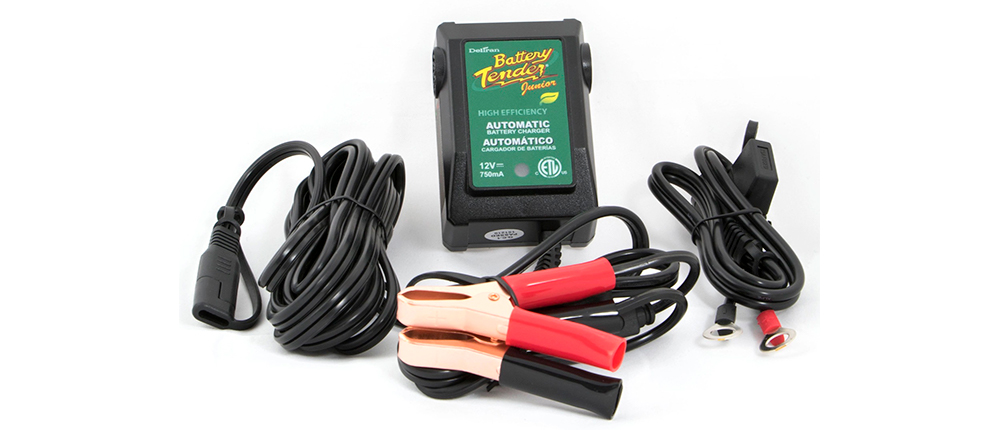
This 1.25V deep cycle battery charger uses smart charging technology. This means that it does everything to send the right level of charge to each battery, considering its type and power level. It all contributes to longer battery life.
The device works as follows: it charges the battery up to 80% and then goes into absorption mode to safely top off the battery without overcharging it. Then, it switches to maintenance mode. The LED light will inform when the charging process is completed.
This Battery Tender Junior is spark-proof. It will also stop working if it spots reverse polarity. However, this is not a water-resistant model, so if your vehicle is parked outside, this model isn’t your perfect option.
Note that it works as both charger and maintainer only for small-engine vehicles. It can only maintain the batteries of large-engine vehicles but not charge them.
Being devised for continuous service, it’s covered with a 5-year warranty. The manufacturer claims to provide a replacement in the case if the Battery Tender Junior will be broken earlier.
Pros
- The voltage is selectable (6V/12V).
- It’s a UL listed product which means that it meets all the national safety standards of the United States.
- The long 6-foot cord saves you from having to use an extension cord.
Cons
- The included alligator clips are small, so it’s difficult to clamp them.
- It takes about 3 – 4 days to charge a battery in full.
Video Battery Tender Junior
NOCO Genius1: Best Deep Cycle Marine Battery Charger
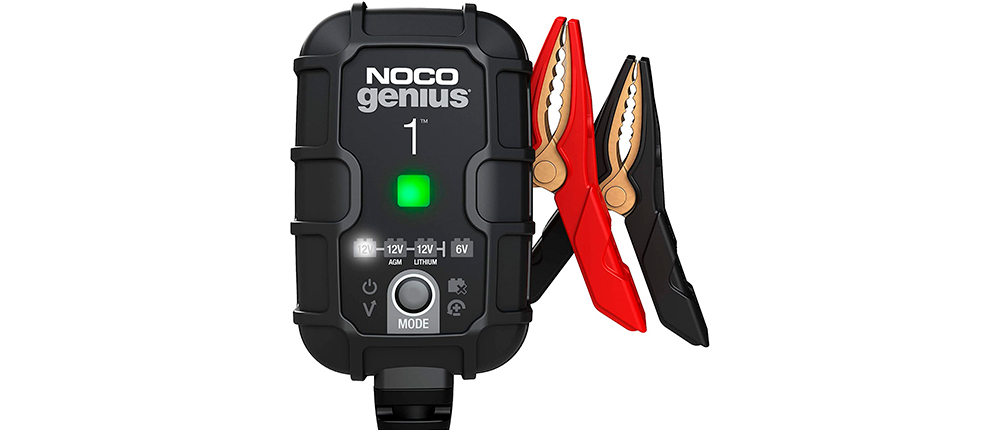
The NOCO GENIUS1 is a 1-Amp charging device, so it supports the “connect and forget” principle. Besides, it can be plugged into an outlet and can be used for a lot of different batteries, including even marine ones. Despite its multifunctionality, it’s still one of the most low-cost chargers on the market.
The model has a thermal compensation feature which means that it can work during both extremely hot and cold weather. A special inbuilt sensor automatically detects temperature. So, many people can find this model as the best deep cycle battery charger for all-season maintenance.
Featuring hybrid density technology, the device is able to offer the efficiency of a large system in a small case. The housing is made of Lexan resin that is known for being resistant to shocks and temperature fluctuations. The clamps have the over-molding for increased durability. In addition to that, the GENIUS1 is an IP65 rated device, so it’s impervious to dust and water.
The GENIUS1 can restore the performance of old batteries. It auto-detects sulfation and then activates desulfation mode, guaranteeing longer battery life and a more powerful engine start.
Pros
- You can start the charging process manually thanks to the Force mode.
- The clamps are suitable for a very wide range of battery terminals. They also have great clamping force, providing higher conductivity.
- It has an auto memory function. This means that it automatically returns to the last selected mode.
Cons
- May require several attempts to charge a flat battery.
- Due to its limited amperage (1A), it requires more than 5 days to charge a large vehicle battery.
Video NOCO Genius1
NOCO Genius10
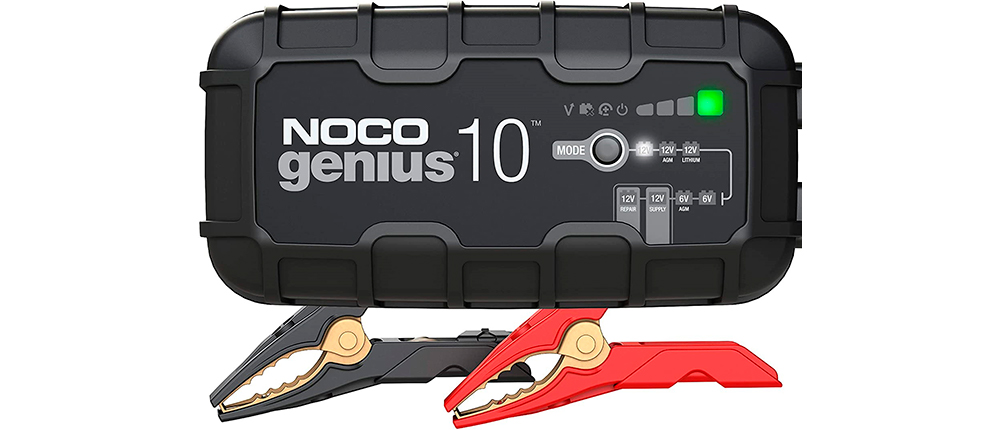
This 10-Amp model is a decent deep cycle battery charging device for the owners of large-engine vehicles. It’s a multi-voltage and multi-type charger.
This charger is optimized for different temperatures and provides charging and protection of your battery during very low and very high ambient temperatures.
It isn’t a pocket-sized model, so it will take some space in your toolbox. However, it comes with mounting brackets, so if you aren’t going to carry it with you anywhere, you can hang the charger on the wall.
This advanced model offers 3 charging modes:
- Repair mode restores the lost performance of old batteries. It’s also completely automatic.
- 12V Supply mode is devised for 12V devices, such as tire inflator, for example.
- Force mode allows you to activate the charging process manually. This mode also allows you to detect the malfunctions of your battery: if the mode won’t work, this means that the battery must be examined additionally.
You can switch between all the functions using only one Mode button.
Pros
- The start-voltage sensor to precisely detect the voltage level of the connected battery to eliminate overcharging.
- A 3-color indicator that shows the battery’s charge level.
- It features a dynamic battery tracking function which means that it can detect the current status of the battery.
Cons
- It isn’t water-resistant, so we recommend it for indoor use.
- It takes more than 17 hours to charge a battery which is quite a lot as for a 10-Amp model.
Video NOCO Genius10
NOCO Genius5
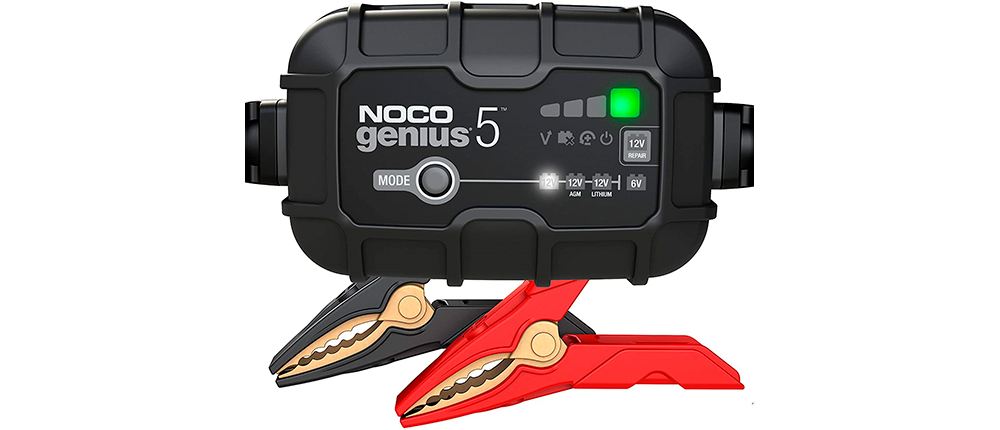
This smart unit for charging deep cycle battery has a maximum charge amperage of 5V.
It’s fully automatic, so you can deal with it even if you do not know about such charging devices.
This model offers 6 charging programs: three 12V programs for different types of batteries, 6V, Force mode (for batteries that are under 1V), and 12V Repair mode. However, unfortunately, it doesn’t have a low current mode, so it can’t be used with smaller batteries (below 6V).
You can find out about the charge level of your battery thanks to 4-color LEDs. There are also several error LEDs that will let you know if the battery isn’t able to hold the charge, the voltage is too high for the selected mode, and in case of reverse polarity.
The GENIUS5 has a universal, 120-240 VAC input, and is compatible with all types of vehicles, so can be used as a deep cycle marine battery charger. It also can operate at temperatures ranging from -4°F to +104°F.
The device uses an innovative charging algorithm that allows it to top off the battery two times faster than the traditional chargers do. It requires about 3 hours to power up a 20Ah battery, and 18 hours maximum to recharge a 120Ah battery.
In the cardboard box, you will find well-built battery clamp connectors and a kit for a wall mount.
Pros
- The clamps have rubber covers that provide dust- and water-resistant sealing.
- It uses a natural convection cooling system which means that the charger can’t get hot during operation.
- The charger features a corrosion-resistant housing.
Cons
- The kit lacks a set of eyelet connectors.
- The manufacturer warns that a frozen or damaged battery potentially can cause an explosion if you connect it to the charger and leave it unattended. Hence, this model isn’t 100% safe as a maintainer.
Video NOCO Genius5
NOCO Genius G3500
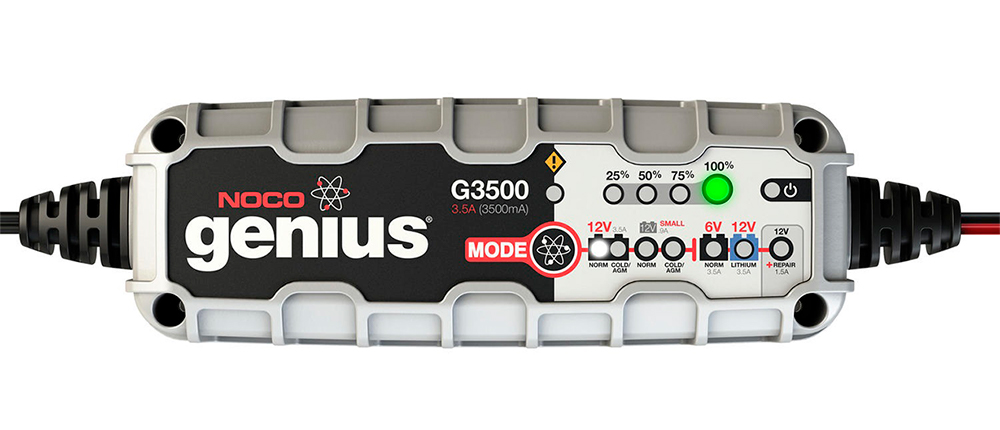
This charger by NOCO will charge literally any kind of battery: gel, 6V motorcycle battery, 12V battery, etc. Simply select the button on the front panel which matches with the type of a battery, and the rest will be done by the charger. Moreover, it has a solid case, resistant for water and drops. In any case, you shouldn’t care about possible damages: two extra fastening holes will reliably fix the device on the desirable surface. Plus, it has very small overall dimensions: apart from the wires, the device is the size of a soda can. The charger works in relatively cold weather (below 10°), so there is no need to keep it in a warm room, it will safely work in the unheated garage.
The charger has a clear interface. Put it on the charge, and go minding your own business. You can periodically look at the top row of indicators that show when it’s charged at 25-50-75-100%, then the NOCO Genius switches into a standby mode.
Pros
- It comes along with a battery diagnosis tool.
- Despite the size, it can pump energy into a car or a truck battery without any efforts.
Cons
- The red light indicator is weak, it’s poorly noticeable in the daylight.
Video NOCO Genius G3500
Schumacher SC1281
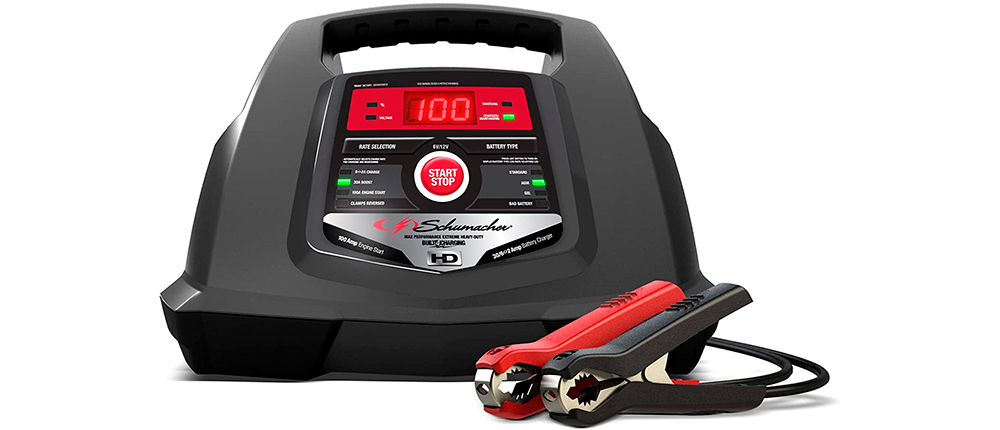
This appliance has broad capabilities to help your battery stay in working condition. The Schumacher SC1281 works as a charger, analyzer/tester, maintainer, engine starter, and desulfator.
This 100-Amp model can help you start SUV or truck (thanks to the 30A quick boost feature) and can work with large car and marine batteries.
Its fully automatic work provides great safety and correctness. The appliance uses 3-stage charging, controlled by a multiprocessor. It also has an auto-voltage detection feature.
The Schumacher deep cycle battery charger is noticeably heavy (12.65 pounds) and not compact (11 x 10 x 8 inches) but has an ergonomic carrying handle. It also features an LED digital display showing voltage and percentage of charge. The SC1281 requires a 120V outlet for operation.
As soon as you hook up the battery, the diagnosis starts. If it detects any malfunction,
it will inform you about this with the help of an LED. If immediate work is needed, just press the large start/stop button in the very center.
Functioning as a maintainer, it can support the proper level of voltage in the battery if you are not going to drive your car for many months.
Pros
- This model is Schu Eco Energy and DOE compliant, so it meets all the important safety standards.
- Desulfation takes a minimum of time (around 8 hours).
- The housing quickly becomes cool after the initial charging is completed, so don’t worry about overheating.
Cons
- Clamps have a bit weak clamping force.
- It may require several charging sessions to restore the old battery’s performance.
Video Schumacher SC1281
Schumacher SC1280
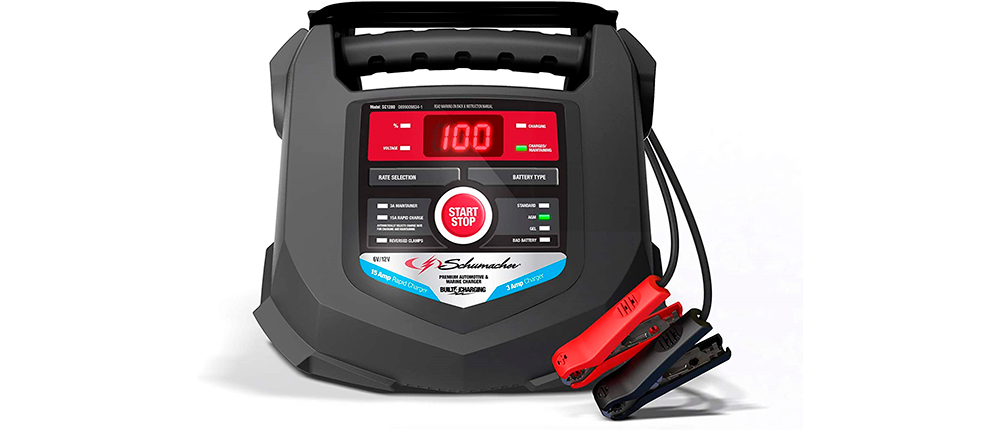
The SC1280 is a 15A model that also can function as a trickle charger, providing a sustainable charge without overcharging. Note that it isn’t a high-powered unit, so for large vehicles, it works only as a maintainer.
This unit is one of those deep cycle battery chargers that work for automotive and marine batteries. It can be bought for AGM, gel cell, and deep-cycle batteries. However, it doesn’t auto-detect the battery type. You must choose it manually with the help of the Battery Type button.
The digital display and LED indicators give you real-time updates about the charging process. It also has a start/stop button that you can press to immediately start or stop charging.
Being controlled by a smart microprocessor, it will automatically turn off when the charging process is completed.
This model is made as a fully sealed unit so water or dust can’t get to its inner parts. This way, you can feel free to use it outdoors even when it’s raining. It also has a convenient handle with a rubber grip for transportations.
Pros
- Being rated for 800 CCA, this model is able to start your vehicle when it’s cold outside.
- The LEDs are extremely bright; they are very clearly visible even from afar.It takes only 10 hours to charge a dead car battery.
- It takes only 10 hours to charge a dead car battery.
Cons
- After several hours of charging, it automatically activates a power-saving mode and stops showing charging level and status.
- Sometimes the screen gets stuck on a certain percentage for no reason
Amazon Basics
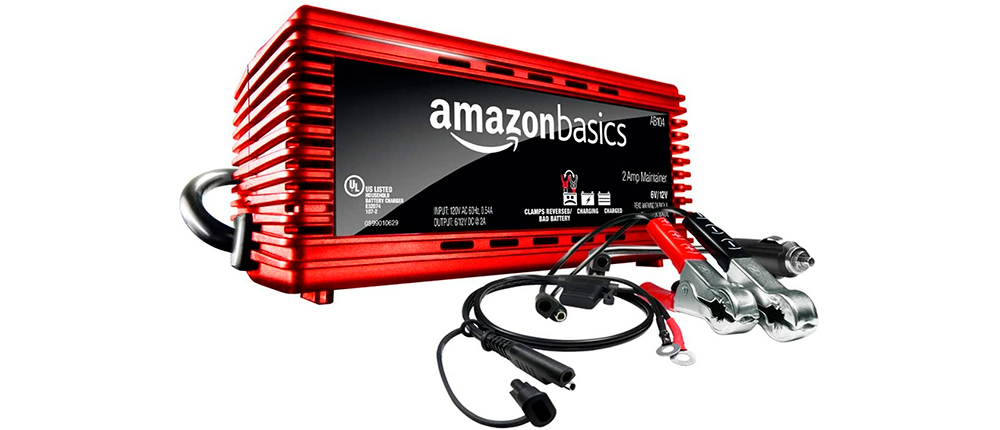
This 2A charger works for 12V batteries. It has the Float mode that helps it automatically support the optimal charge level in your battery and function as a maintainer. The model also can revive batteries that are less than 1 Volt. It can be used for charging batteries from cars, motorcycles, boats, lawn mowers, etc.
The unit has fully automatic work, controlled by an intelligent microprocessor. It automatically detects the battery’s voltage and then triggers the multi-stage charging process.
This 12V deep cycle battery charger has LEDs that will inform you if the clamps are reversed and if the battery can’t be charged.
Unfortunately, it doesn’t show the charge level. It also can’t recharge badly drained batteries. It’s simply not powerful enough to do that.
The housing is made of durable, thick plastic that ensures durability. However, it should be used indoors only.
Pros
- It doesn’t get hot during operation.
- The charger is able to work during cold temperatures, so it can maintain your battery during the winter period.
- This model comes with 3 accessories: battery clamps with quick-connect harness adapter, 12V DC adapter, and 24-inch fused ring leads harness with a weather protective cap.
Cons
- It acts only as a trickle charger, and, hence, won’t help you jump start your vehicle.
- This model doesn’t have sparkproof protection.
Buyer’s Guide
Does a regular charger suit for a deep cycle battery?
Practically, the usual chargers are not great helpers in the event of a dead deep cycle battery. The max level of discharge should not exceed 25%. We would advise using the charges with automatic control or with integrated three-step charging.
What are the reasons to acquire a deep cycle battery charger?
Every battery starts to deteriorate when it is discharged below 11V: the sulfate starts forming on the plate surface, ultimately leading to decreased performance. Moreover, deep discharge is the main reason for partial separation and plates warping. The deep cycle battery tender helps get rid of this problem thanks to the intermittent current.
In the event of car battery overcharging, it will never recharge without problems again and may even break. The automatic power off function won’t let this happen. Furthermore, when your car battery is discharged to 0%, it’s no longer possible to use the alternator to charge it. In such instances, the deep cycle battery charger is very helpful for car starting.
Can a deep cycle battery charger help with charging a regular battery?
Without any doubts, it can be used as an average battery, as it doesn’t have many differences compared to the usual charger. It has a purpose to supply less power during a long time, while an average charger gives a big quantity of power during a short period. However, in general, they’re playing the same role.
What is needed for proper deep cycle battery keeping?
The deep-discharge batteries have thick plates, they are solid and definitely not as fragile as the normal batteries are. They can endure deep discharges. Despite all these tough qualities, it’s desirable not to discharge the battery completely on a constant base to avoid sulfation. Thus, the battery will work as satisfactorily as possible and will be serving for a very long time.
The battery requires special attention when it comes to charging. The charger should take into consideration its temperature and operation mods.
It can be technically difficult if you try to use manual settings to charge different types of batteries. So it is desirable to use an intelligent charger to run the charging process. We also advise checking the voltage level of the battery semiannually. It shouldn’t fall below 11V.
How to use a deep cycle battery charger in a proper way?
The deep discharge battery has some differences if compared to a typical battery. Notwithstanding that it endures discharged up to 15%, keep the battery always half charged to increase its life term.
Even if you have already had an opportunity to use such battery and know how it works, every model has its own peculiarities. So before charging a new deep cycle battery, it’s better to get acquainted with the user’s manual.
Keep in mind that the battery will be discharging independently in about 15% every month while you are not using it. This way, the sulfation will begin after half a year in the workless state. Some kinds of chargers are supplied with an auto charging function.

